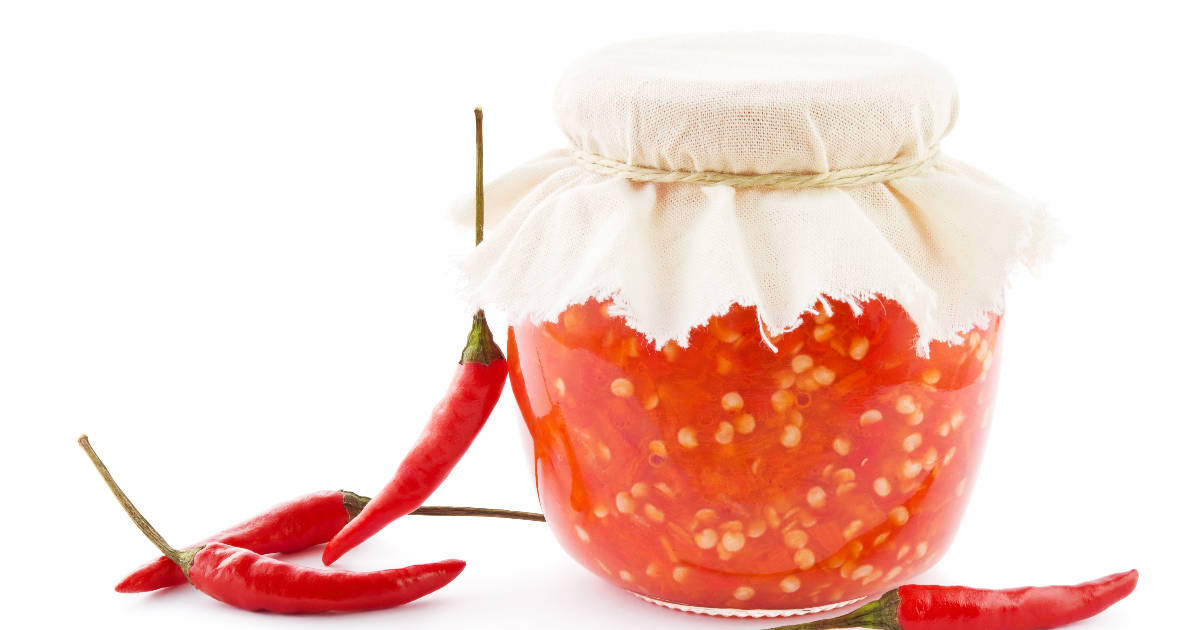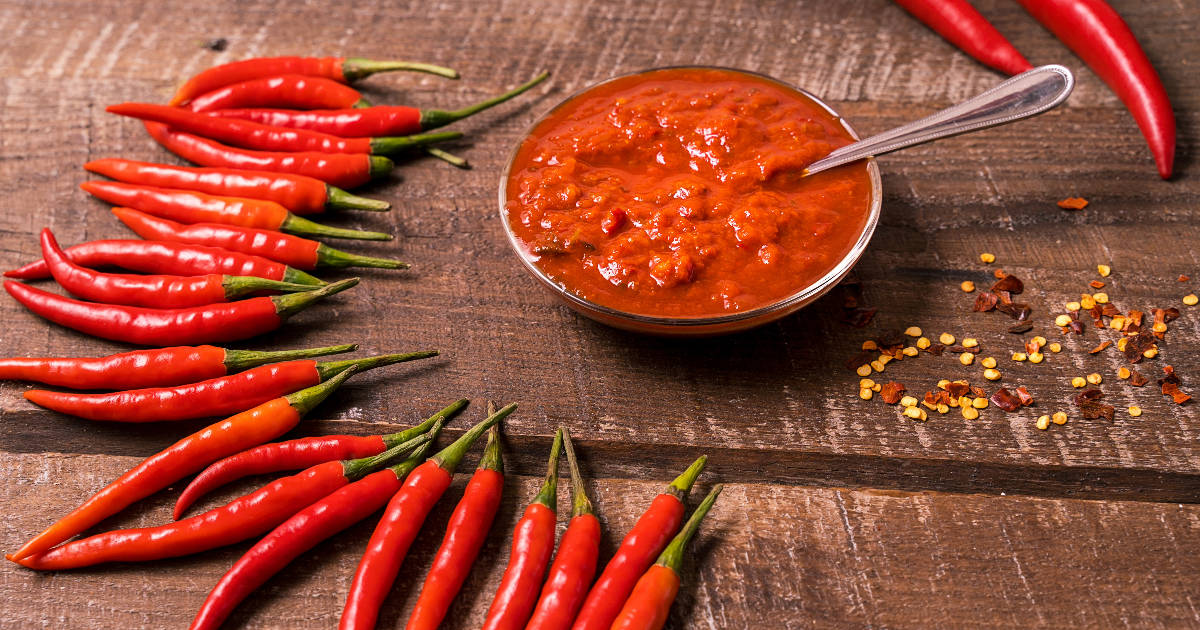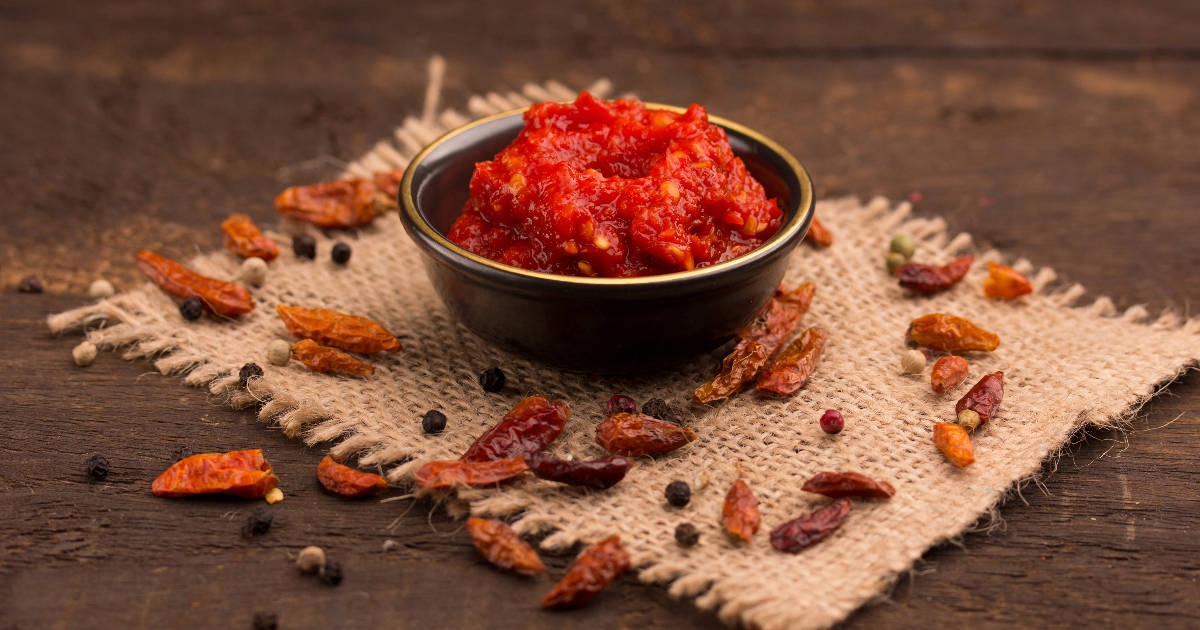Harissa and sambal oelek are two of the most popular spicy condiments in their respective regions.

While they share some similarities, their flavors and uses differ.
Understanding the basics of these pastes helps you use them properly in the kitchen.
What is Harissa Paste?

Harissa hails from North Africa, especially Tunisia. It consists of roasted red peppers blended with garlic, spices like caraway and cumin, olive oil, and sometimes rose petals. This paste has a texture akin to tomato paste. The taste is complex, slightly smoky, and medium spicy.
Traditionally, harissa paste gets pounded in a mortar and pestle. Now, most cooks use a blender or food processor. The paste lasts for weeks refrigerated and freezes well too.
How is Harissa Paste Used?
This versatile condiment livens up many savory dishes in North African and Middle Eastern cuisine. Here are some popular uses for harissa paste:
- Marinades - The paste makes a superb spicy marinade base for chicken, meat, fish, or veggies before grilling or roasting.
- Salad dressings - Whisk harissa into vinaigrettes and drizzle over salads.
- Sandwich spread - Slather some harissa paste onto meats or falafel in sandwiches.
- Soup and stew flavoring - Stir in harissa to add heat and depth to all kinds of soups and stews.
- Hummus and dips - Swirl the paste into hummus, baba ghanoush, and more dips for a kick.
- Meat rubs - Combine harissa with olive oil and use it as a spicy rub for lamb, beef, and chicken.
So harissa paste plays many culinary roles! It provides a distinct North African flavor profile.
What is Sambal Oelek?

Sambal oelek hails from Indonesia and Southeast Asia. It consists of only three ingredients: ground red chili peppers, vinegar, and salt. This simplicity gives sambal oelek a clean, pure chili flavor.
The texture falls somewhere between a relish and a paste. It spreads easily but remains thick. You only need a dollop to add serious heat to a dish!
How Does Sambal Oelek Differ From Other Chili Pastes?
While all spicy chili pastes, sambal oelek stands apart from other popular options:
- Sriracha - Sweet and tangy with garlic notes, unlike sambal oelek.
- Gochujang - Fermented chili paste with sweet and funky flavors from Korean cuisine.
- Harissa - Smoky and complex with spices like cumin.
- Chili garlic sauce - Similar to sambal oelek but with extra garlic. Easily swapped.
So sambal oelek remains light and clean, letting the chili flavor shine.
How is Sambal Oelek Used?
In Southeast Asian cooking, cooks use sambal oelek at the start of recipes as a flavor base. Here are some classic uses:
- Stir-fries - Add sambal oelek when cooking aromatics for extra heat.
- Soups and curries - Stir in sambal oelek to elevate savory broths.
- Salsas and dressings - Mix in the chili paste for a spicy kick.
- Satays, spring rolls, and more - Serve alongside as a dipping sauce.
- Noodles and rice dishes - Add as a condiment to noodles and rice bowls.
With its simplicity, sambal oelek boosts heat and complements other robust Southeast Asian flavors.
Exploring Regional Varieties of Each Paste
Both harissa and sambal oelek see countless regional iterations, adjusted to local tastes:
Harissa by Region
- Tunisian - Most famous; often uses baklouti peppers. Milder than others.
- Moroccan - Features unique sweet and smoky dried red peppers.
- Algerian - Known for more garlic and lemon flavors.
- Libyan (filfel chuma) - Uses caraway instead of cumin.
Sambal Oelek by Region
- Padang - Features kaffir lime and lemongrass.
- Bali - Adds kecombrang flower for a unique flair.
- Manado - Uses fiery bird's eye chilis and lemon.
- Java - More sweet and tangy thanks to palm sugar and tamarind.
So both pastes offer exciting regional variations!
Making Harissa Paste and Sambal Oelek at Home
You can easily DIY both harissa and sambal oelek.
For harissa paste:
- Soak dried peppers, then blend with garlic, spices, oil, and lemon juice.
- Let the flavors meld overnight before using.
For sambal oelek:
- Combine chopped fresh chilis, vinegar, and salt in a food processor.
- Blend to your desired texture.
- You can use it right away or store it in the fridge.
Adjust any recipe to your personal tastes - add more heat, tang, or funk as you like.
FAQ
What's the difference between harissa paste and sambal oelek?
The main difference is their flavor profiles and origins. Harissa paste comes from North Africa and has a deeper, smokier taste from spices like cumin and caraway. Sambal oelek hails from Indonesia and highlights the pure heat and flavor of chili peppers.
What kinds of dishes use harissa paste?
Harissa paste excels at adding medium heat and richness to Middle Eastern and North African dishes. Use it in marinades, salad dressings, sandwich spreads, dips like hummus, and more. It's also great for spicing up soups, stews, and tagines.
What are some ways to use sambal oelek?
In Southeast Asian cooking, cooks use sambal oelek to elevate stir-fries, curries, soups, noodle bowls, and more. It also makes a tasty condiment for dipping sauces. The simplicity of sambal oelek allows the chili flavor to shine.
Can you make harissa and sambal oelek at home?
Yes! For both pastes, you'll blend up some chili peppers and aromatics. Harissa uses more warm spices, while sambal oelek keeps it simple. You can customize each paste to suit your tastes. Making them yourself lets you control the heat level and flavors.
What are some regional varieties of harissa paste?
Some examples include spicy Tunisian harissa, smoky Moroccan harissa with special dried peppers, and Algerian harissa with more garlic and lemon. Each region has put its own spin on the paste.
Conclusion
Harissa paste and sambal oelek offer unique flavors from their respective regions. Harissa shines in North African and Middle Eastern dishes, while sambal oelek excels in Southeast Asian cuisine.
Both pastes can be tweaked endlessly by using different peppers and custom spice blends.
With some chili paste inspiration, it’s easy to add excitement to all your savory meals.
Try making them from scratch and experiment with new recipe ideas. Your taste buds will thank you!

